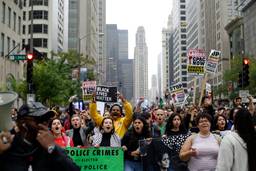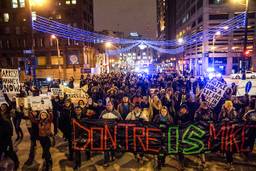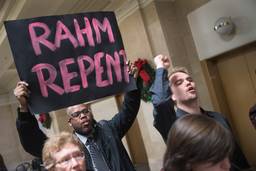The Black Panther Party and the “Undying Love for the People”
The new documentary The Black Panthers, Vanguard of the Revolution is full of insights for today’s racial justice activists.
Flint Taylor

Starting with a premiere at the Sundance Film Festival, Stanley Nelson, Laurens Grant, Aljernon Tunsil, and Firelight Media’s made-for-PBS documentary on the history of the Black Panther Party has been touring the country. The feature length film — named, not without a touch of irony, The Black Panthers, Vanguard of the Revolution—has attracted large audiences, much acclaim, and some criticism, most notably from former Black Panther leader Elaine Brown, who called it “a two-dimensional palliative for white people and Negroes who are comfortable in America’s oppressive status quo.”
Nelson, Grant and Tunsil are African-American documentary filmmakers of note, having to their collective credit documentaries on Emmet Till, Freedom Summer, Jesse Owens and the Freedom Riders. In his director’s statement, Nelson describes his mission in making the film:
Seven years ago, I set out to tell the story of the rise and fall of the Black Panther Party, a little known history that hadn’t been told in its entirety. In particular, I wanted to offer a unique and engaging opportunity to examine a very complex moment in time that challenges the cold, oversimplified narrative of a Panther who is prone to violence and consumed with anger. Thoroughly examining the history of the Black Panther Party allowed me to sift through the fragmented perceptions and find the core driver of the movement: the Black Panther Party emerged out of a love for their people and a devotion to empowering them. This powerful display of the human spirit, rooted in heart, is what compelled me to communicate this story accurately.
Several powerful documentaries paved the way for Firelight’s film. In 1969, radical filmmakers Mike Gray and Howard Alk made a black-and-white 16 millimeter film called American Revolution II, which chronicled the Chicago Black Panther Party’s efforts in forging a Rainbow Coalition among white, Puerto Rican and African-American organizations.
During their filming, Gray and Alk were inspired by a 21-year-old messianic Black Panther Party leader, Chairman Fred Hampton, and set out making a sequel to American Revolution II. They shot some remarkable footage of Hampton and the Chicago Panthers, but before they had finished the film, Hampton was murdered in his bed, the victim of a conspiracy hatched as part of the FBI’s then-secret COINTELPRO program and executed by the Chicago police and the State’s Attorney of Cook County, Edward V. Hanrahan.
Summoned to the apartment to film the murder scene, Gray and Alk then transformed their film into The Murder of Fred Hampton, which powerfully proved Hanrahan’s claim that the Panthers shot it out with the police to be a bold-faced lie, and that the raid was in fact a pre-planned police murder. The movie premiered at the Cannes Film Festival, but was not widely viewed in this country. It was, however, seen in New York City by a young man named Stanley Nelson.
In 1987, African-American film producer Henry Hampton’s series Eyes on the Prize aired on PBS. The six-part series documented the early civil rights struggle, and three years later, PBS aired Eyes on the Prize II. This eight-part sequel chronicled the evolution of the civil rights struggle during the last half of the 1960s and through the 1970s as it moved north, became radicalized while also entering the realm of electoral politics.
One episode, entitled “Power” and narrated by Julian Bond, described the rise of the Black Panther Party in Oakland California and featured interviews with former national BPP leaders Huey P. Newton and Bobby Seale. A few weeks later, Henry Hampton, his director, Terry Rockefeller, and their film company, Blackside, presented an episode called “A Nation of Laws?” In this episode, the filmmakers, armed with evidence unearthed by Fred Hampton’s lawyers over a decade of litigation, and the investigation conducted by Senator Frank Church’s Intelligence Committee, made out a compelling case that Fred Hampton was a charismatic young leader of a dynamic revolutionary organization who was the victim of a nationwide FBI conspiracy to destroy the Black Panther Party, a conspiracy that was part and parcel of FBI Director J. Edgar Hoover’s COINTELPRO.
This episode featured the only known interview with FBI informant-provocateur William O’Neal, who drew the floorplan that the police used in their murderous raid, and who received a $300 bonus for his integral role in the conspiracy. “A Nation of Laws?” also made an early link between police repression and the issue of mass incarceration through Angela Y. Davis, who provided a bridge from the Hampton assassination to the second half of the episode which documented the 1971 Attica prison rebellion and its bloody suppression, on orders from Governor Nelson Rockefeller, by the New York State Police.
Nearly two decades passed before another documentary treated the BPP, Fred Hampton and the FBI’s program to destroy the Party. This time it was BET, oddly enough, in its series called American Gangster. In an hour-long episode that aired in 2008, BET crowned J. Edgar Hoover as an all-powerful law enforcement gangster and traced his decades-long war against all manner of black organizations and leaders. Honing in on COINTELPRO and its attempt to destroy Martin Luther King, the show condemned Hoover and the FBI as virulent racists who, after King’s assassination, joined hands with the newly elected Richard Nixon to continue its war on the black liberation movement, cloaked as a war on crime. The show climaxed by documenting in detail how the murder of Fred Hampton was COINTELRPO’s racist end game in the FBI’s plot to destroy the Black Panther Party.
So it was with this historical backdrop that Nelson and Grant set out to recount the short but complicated history of the Black Panther Party, starting in California in 1966 with the Party’s founding and its bursting on the national scene with its dramatic march into the California state legislature, legally holding guns while Governor Ronald Reagan was holding a press conference on the Capitol’s steps. Using remarkable black-and-white archival footage, the current voices of more than twenty former Panthers, a former FBI agent, several retired police officers, a number of Panther lawyers and community activists, and a collection of historians (rather than a narrator), and accompanied by some soul stirring period music , the fast-paced movie opens with the Chi-Lites belting out “Give More Power to the People” and takes the viewer through the police slaying of little Bobby Hutton, Huey Newton’s shootout with the Oakland police and the world-wide movement to “Free Huey.”
It shines a light on the many BPP community programs, from serving breakfast to thousands of children to publishing a weekly paper best known for its dissemination of the BPP’s 10-Point program and the art of Emory Douglas, which most often displayed his almost limitless capacity to depict police as all manner of pigs. It also shows the vital importance that young women played in the day-to-day operations of the Party — several of the Party’s female leaders, most notably Erica Huggins, Kathleen Cleaver, Elaine Brown and Phyllis Jackson have important roles in narrating the Party’s history.
Vanguard of the Revolution also takes a serious look at the developing division within the party between the imprisoned Newton and Eldridge Cleaver, who had risen to prominence in Newton’s absence and had later fled to Algeria and opened up an international section of the Party. The film also shows how the FBI took glee in attempting to foment and further exacerbate that conflict and other political differences that arose between the Panthers and other organizations. But the heart of the film is the recounting of a number of events that reflect the government’s unremitting repression of the Party and how the Party attempted to resist, yet ultimately succumbed, to this onslaught.
One such method was the arrest and prosecution of Panther leadership. Beyond the arrest and prosecution of Huey Newton, the film also deals at length with the jailing of the New York Panther leadership, in a case that became known as the Panther 21. Through the voice on Jamal Joseph, who, at the age of 16 was rounded up as one of the 21, and one of his lawyers, the viewer is familiarized with their trumped-up and politically motivated arrest, prosecution and, in one of the few joyous moments in the film, their acquittal and victory celebration. The film also documents the targeting of Bobby Seale as one of the alleged co-conspirators in the notorious Conspiracy 8 trial in Chicago in 1969, and his being viciously bound and gagged by Judge Julius Hoffman when Seale attempted to represent himself.
The second form of repression, which we now know was coordinated and orchestrated nationally by the FBI, was police violence — most commonly in the form of raids on Panther offices and homes that lead to injury, death and the mass arrests of Panthers who defended themselves against police. Most infamous of these attacks was the police assassination of Fred Hampton and Mark Clark on December 4, 1969. While Vanguard of the Revolution does not plow ground not covered in prior films, it does accurately portray Hampton as the remarkable young leader that he was, showing numerous clips from The Murder of Fred Hampton, beginning with Hampton’s stirring speech at the Federal Courthouse (after Seale was gagged and jailed) in which he proclaimed that “you can jail a revolutionary, but you can’t jail a revolution.”
The film also gives appropriate prominence to Hampton’s assassination in the history of the Black Panther Party. Using much of Mike Gray’s footage, as well as portions of informant O’Neal’s interview from Eyes on the Prize II, this segment also relies on the voices, then and now, of raid survivor Akua Njeri (Deborah Johnson), several former Chicago Panthers, two of Hampton’s lawyers and an African-American police officer to retell the chilling tale. Notably absent is the voice of longtime U.S. Congressman Bobby Rush, who was the very prominent Minister of Defense of the Chicago Chapter who miraculously avoided a fate similar to Hampton’s on December 4. But Mike Gray is an important voice in the re-telling and gives a unique perspective as a filmmaker who chronicled the events in real time.
Bookended with the Hampton assassination in the film is the police raid on the Los Angeles Black Panther offices only four days later. Unlike the pre-dawn raid on Hampton’s apartment, this raid was met with armed Panther resistance. Through the eyes of three of the men who were present — Wayne Pharr, Roland Freeman and Gil Parker — we experience firsthand the gun battle that took place for many hours and the Panthers’ ultimate surrender. In one of the film’s most powerful moments, when Pharr, who has since died, was asked how he felt as he fired back at the police, he responded, “I felt free, I felt absolutely free.”
As the film heads to its conclusion, we see the results of the repression on the Panthers and the divisions within the Party as the Oakland Chapter turns to electoral politics and Bobby Seale runs for Mayor of Oakland. What we do not see is the emergence of an underground iteration of the Panthers known as the Black Liberation Army, which dedicated itself to armed actions and armed struggle and which engaged in some high-profile confrontations with police that left several police officers dead and numerous BLA members, including Assata Shakur and Sundiata Acoli, charged with capital crimes.
The film is not a complete history. The narration favors Kathleen Cleaver and her view of the history over that of Elaine Brown; George Jackson’s role in the Party’s evolving ideology is omitted, as is Angela Davis, Geronimo Pratt and the BLA; and Bobby Seale has withheld his very important current voice from the film. It could also be said that it glosses over the very real issue of male chauvinism in the Party, although Elaine Brown does briefly acknowledge that it was a problem. The documentary concludes on a down note, depicting Huey in his post-prison years as a violent, dope-addled, underworld kingpin — one former Panther called him a “fucking maniac” — while noting that Eldridge Cleaver went on to be a born-again Christian and political supporter of Ronald Reagan.
With Gil Scott Heron’s mournful “Winter in America” as the backdrop, those blows are softened somewhat by the film’s final act: the separate reading of each of the points in the Panther’s 10 Point Program by several of those former Panthers whose voices have become familiar during the movie, and by Jamal Joseph’s proclamation that, for all its youthful mistakes and over-exuberance, the Black Panther Party was motivated, at bottom, by an “undying love for the people.”
As one of the lawyers who fought to transform the narrative about the Black Panther Party and the assassination of Fred Hampton both through courtroom litigation and by working with various committed filmmakers over the years — including those at Blackside and Firelight — these omissions and criticisms, in my view, pale in comparison to what Firelight has succeeded in telling, primarily through the voices of those now-greying Black Panthers who lived through it. In their youth, these and many more Panthers courageously made people’s history. That history is somewhat imperfectly, but most powerfully, narrated in this film, and the lessons to those engaged in today’s struggles against racism and for justice are there for all to see. Can we ask for more from a documentary filmmaker?







